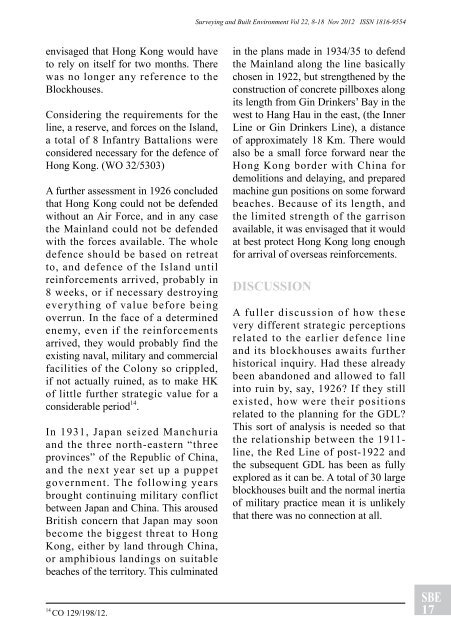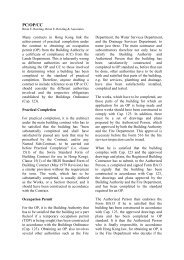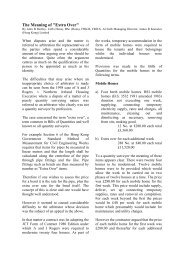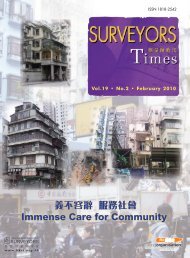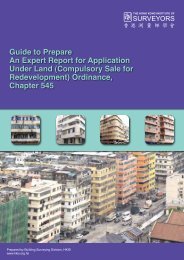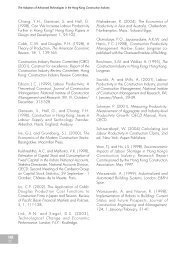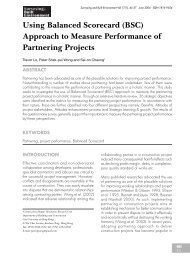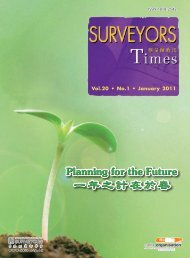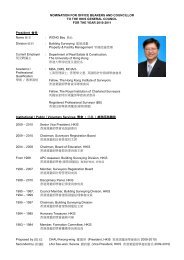Surveying & Built Environment Vol. 22 Issue 1 (December 2012)
Surveying & Built Environment Vol. 22 Issue 1 (December 2012)
Surveying & Built Environment Vol. 22 Issue 1 (December 2012)
You also want an ePaper? Increase the reach of your titles
YUMPU automatically turns print PDFs into web optimized ePapers that Google loves.
envisaged that Hong Kong would have<br />
to rely on itself for two months. There<br />
was no longer any reference to the<br />
Blockhouses.<br />
Considering the requirements for the<br />
line, a reserve, and forces on the Island,<br />
a total of 8 Infantry Battalions were<br />
considered necessary for the defence of<br />
Hong Kong. (WO 32/5303)<br />
A further assessment in 1926 concluded<br />
that Hong Kong could not be defended<br />
without an Air Force, and in any case<br />
the Mainland could not be defended<br />
with the forces available. The whole<br />
defence should be based on retreat<br />
to, and defence of the Island until<br />
reinforcements arrived, probably in<br />
8 weeks, or if necessary destroying<br />
everything of value before being<br />
overrun. In the face of a determined<br />
enemy, even if the reinforcements<br />
arrived, they would probably find the<br />
existing naval, military and commercial<br />
facilities of the Colony so crippled,<br />
if not actually ruined, as to make HK<br />
of little further strategic value for a<br />
considerable period 14 .<br />
In 1931, Japan seized Manchuria<br />
and the three north-eastern “three<br />
provinces” of the Republic of China,<br />
and the next year set up a puppet<br />
government. The following years<br />
brought continuing military conflict<br />
between Japan and China. This aroused<br />
British concern that Japan may soon<br />
become the biggest threat to Hong<br />
Kong, either by land through China,<br />
or amphibious landings on suitable<br />
beaches of the territory. This culminated<br />
14 CO 129/198/12.<br />
<strong>Surveying</strong> and <strong>Built</strong> <strong>Environment</strong> <strong>Vol</strong> <strong>22</strong>, 8-18 Nov <strong>2012</strong> ISSN 1816-9554<br />
in the plans made in 1934/35 to defend<br />
the Mainland along the line basically<br />
chosen in 19<strong>22</strong>, but strengthened by the<br />
construction of concrete pillboxes along<br />
its length from Gin Drinkers’ Bay in the<br />
west to Hang Hau in the east, (the Inner<br />
Line or Gin Drinkers Line), a distance<br />
of approximately 18 Km. There would<br />
also be a small force forward near the<br />
Hong Kong border with China for<br />
demolitions and delaying, and prepared<br />
machine gun positions on some forward<br />
beaches. Because of its length, and<br />
the limited strength of the garrison<br />
available, it was envisaged that it would<br />
at best protect Hong Kong long enough<br />
for arrival of overseas reinforcements.<br />
dISCuSSIoN<br />
A fuller discussion of how these<br />
very different strategic perceptions<br />
related to the earlier defence line<br />
and its blockhouses awaits further<br />
historical inquiry. Had these already<br />
been abandoned and allowed to fall<br />
into ruin by, say, 1926? If they still<br />
existed, how were their positions<br />
related to the planning for the GDL?<br />
This sort of analysis is needed so that<br />
the relationship between the 1911-<br />
line, the Red Line of post-19<strong>22</strong> and<br />
the subsequent GDL has been as fully<br />
explored as it can be. A total of 30 large<br />
blockhouses built and the normal inertia<br />
of military practice mean it is unlikely<br />
that there was no connection at all.<br />
SBE<br />
17


